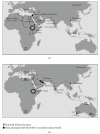Upper Pleistocene Human Dispersals out of Africa: A Review of the Current State of the Debate
- PMID: 21716744
- PMCID: PMC3119552
- DOI: 10.4061/2011/615094
Upper Pleistocene Human Dispersals out of Africa: A Review of the Current State of the Debate
Abstract
Although there is a general consensus on African origin of early modern humans, there is disagreement about how and when they dispersed to Eurasia. This paper reviews genetic and Middle Stone Age/Middle Paleolithic archaeological literature from northeast Africa, Arabia, and the Levant to assess the timing and geographic backgrounds of Upper Pleistocene human colonization of Eurasia. At the center of the discussion lies the question of whether eastern Africa alone was the source of Upper Pleistocene human dispersals into Eurasia or were there other loci of human expansions outside of Africa? The reviewed literature hints at two modes of early modern human colonization of Eurasia in the Upper Pleistocene: (i) from multiple Homo sapiens source populations that had entered Arabia, South Asia, and the Levant prior to and soon after the onset of the Last Interglacial (MIS-5), (ii) from a rapid dispersal out of East Africa via the Southern Route (across the Red Sea basin), dating to ~74-60 kya.
Figures




Similar articles
-
Human dispersals out of Africa via the Levant.Sci Adv. 2023 Oct 6;9(40):eadi6838. doi: 10.1126/sciadv.adi6838. Epub 2023 Oct 4. Sci Adv. 2023. PMID: 37792942 Free PMC article.
-
The success of failed Homo sapiens dispersals out of Africa and into Asia.Nat Ecol Evol. 2018 Feb;2(2):212-219. doi: 10.1038/s41559-017-0436-8. Epub 2018 Jan 18. Nat Ecol Evol. 2018. PMID: 29348642 Review.
-
Out of Africa: new hypotheses and evidence for the dispersal of Homo sapiens along the Indian Ocean rim.Ann Hum Biol. 2010 Jun;37(3):288-311. doi: 10.3109/03014461003639249. Ann Hum Biol. 2010. PMID: 20334598
-
Out of Africa, but how and when? The case of hamadryas baboons (Papio hamadryas).J Hum Evol. 2014 Nov;76:154-64. doi: 10.1016/j.jhevol.2014.08.003. Epub 2014 Sep 23. J Hum Evol. 2014. PMID: 25257698
-
On the origin of modern humans: Asian perspectives.Science. 2017 Dec 8;358(6368):eaai9067. doi: 10.1126/science.aai9067. Science. 2017. PMID: 29217544 Review.
Cited by
-
The archaeology of climate change: a blueprint for integrating environmental and cultural systems.Nat Commun. 2025 Jun 13;16(1):5289. doi: 10.1038/s41467-025-60450-9. Nat Commun. 2025. PMID: 40514402 Free PMC article. Review.
-
Climatic windows for human migration out of Africa in the past 300,000 years.Nat Commun. 2021 Aug 24;12(1):4889. doi: 10.1038/s41467-021-24779-1. Nat Commun. 2021. PMID: 34429408 Free PMC article.
-
Always on My Mind? Recognition of Attractive Faces May Not Depend on Attention.Front Psychol. 2016 Jan 29;7:53. doi: 10.3389/fpsyg.2016.00053. eCollection 2016. Front Psychol. 2016. PMID: 26858683 Free PMC article.
-
MIS 3 innovative behavior and highland occupation during a stable wet episode in the Lake Tana paleoclimate record, Ethiopia.Sci Rep. 2024 Jul 24;14(1):17038. doi: 10.1038/s41598-024-67743-x. Sci Rep. 2024. PMID: 39048619 Free PMC article.
-
A Nubian complex site from central Arabia: implications for Levallois taxonomy and human dispersals during the upper Pleistocene.PLoS One. 2013 Jul 24;8(7):e69221. doi: 10.1371/journal.pone.0069221. Print 2013. PLoS One. 2013. PMID: 23894434 Free PMC article.
References
-
- Lahr MM, Foley R. Multiple dispersals and modern human origins. Evolutionary Anthropology. 1994;3(2):48–60.
-
- Vermeersch PM. ‘Out of Africa’ from an Egyptian point of view. Quaternary International. 2001;75:103–112.
-
- Mellars P. Going east: new genetic and archaeological perspectives on the modern human colonization of Eurasia. Science. 2006;313(5788):796–800. - PubMed
-
- Armitage SJ, et al. The southern route “Out of Africa”: evidence for an early expansion of modern humans into Arabia. Science. 2011;331(28):453–456. - PubMed
LinkOut - more resources
Full Text Sources
Research Materials

